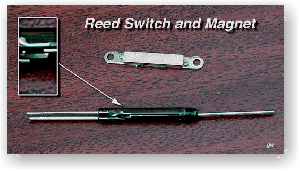REED SWITCHES |
|
| With HLG the aim
is always try to save weight and it down to the absolute
minimum; the latest HLG’s can weigh as little as 9
ounces (250g) for a 4 servo model these days. My tip
then: why not use a reed switch instead of a switch
harness? (Please don’t use this type of switch on a
larger, heavier model though.) A reed switch (for those few of you who don’t know) generally has two flat spring steel wires encapsulated in an inert-gas filled glass tube. When a powerful magnet is brought near the spring steel wires have magnetism induced in them (opposite poles) and the two wires attract one another and make contact. For this tip you need to get hold of a changeover (make and break) reed though. Such a reed switch has one wire in contact all the time - this breaks and the other contact is made when a magnet is brought near. See my image above. The tips of the spring steel wires are often plated with a precious metal such as gold or rhodium to ensure perfect life long contacts. In use you would put the magnet outside the fuselage near the reed switch (they work over a distance an inch, more or less) when the model is not in use. The magnet is removed for flying. The only time you need to open the canopy is at the beginning and end of the day to plug or unplug the battery. (Since it is a changeover switch I even toyed with the idea of having the model solar charge on a stand which switched on for flying, when lifted off, and off for charging when resting on the stand.) Reed Switches like this one are available from Maplin Electronics and Farnell Electronics. |
